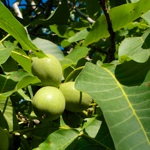Juglans regia
Walnut Καρυδιά

Juglandaceae - walnut family Dicot.
Juglans regia
Walnut Καρυδιά

Juglandaceae - walnut family Dicot.
The value of the walnut tree reflected in its latin epithet Juglans regia, meaning the royal nut of Jove. It has been recognised, since ancient times, wherever it grows, as a important tree for its nuts and timber.
The walnut is a deciduous tree, with spreading branches, bright green in spring and butter yellow in autumn. It is pollinated by the wind and has both male and female flowers on one tree. The male flowers are attractive, long catkins, which appear before the leaves, and the female flowers, from which the fruits develop, are small and inconspicuous, hidden amongst the young leaves. The different flowering times of male and female flowers prevents self-fertilisation.
The fruits of the walnut are green dupes, as are other edible fruits, including peaches, plum and cherries. They have a layer of pulp, with outer skin, surrounding a hard seed-case, the shell, which contains the seed or nut. The seed is divided into two halves, which are deeply wrinkled.
Walnuts are important in the culinary repertoire of Skopelos; where they are preserved in local honey to be served with yoghurt or made into walnut cake, karithopita, for which the International Cafe is famous.
History of the walnut tree
Juglans regia
The walnut tree has been valued for its timber, nuts, oil and dye since ancient times. It has an interesting archaeobotanical history; originating in the tropical forests of the Tertiary period, about 50 million years BP1; it was virtually wiped out by successive ice ages at the onset of the Holocene (about 11,700 BP) and only survived after the Last Glacial maximum in isolated stands in Asia, from China to Caucasus2 From these early beginnings the walnut was dispersed, not by nature but by early humans, along ancient trade routes, further natural expansion created large walnut forests in Central Asia: these persist to this day in Kurdistan.
The walnut tree as well as sweet chestnut and oriental plane trees began to appear in Greece around 3000 years B.P.2 Until recently, it was accepted that cultivated walnuts were introduced into Greece from Asia3 it was known as the Persian walnut, but recent evidence suggests its survival and local exploitation in the Balkans, as well as further west in southern Europe4 The Balkan walnut trees had nuts only at the end of branches and later cross breading, with trees from Anatolia, led to improved yields; trees bearing nuts laterally as well as terminally4
Developments in arboriculture during the Bronze Age, led to distribution of trees more widely in Greece and eastern Mediterranean along with the Mycenaean culture3 Walnuts were considered important and valuable trade commodities at the time of Alexander the Great and continued exchanges along the Silk Road led to further improvement in quality and yields.
During Roman times, the walnut was spread throughout the Empire and was introduced from Southern to Northern Europe and was subsequently introduced to America, although the black walnut, Juglans nigra, which is native to N. America was already growing there.
When walnut trees were first introduced to Skopelos is not known but it was possibly by the Mycenaeans during the Bronze Age or by the Romans; no trees of great age exist, but several mature specimens, probably planted in modern times, are highly prized and the nuts are considered a culinary luxury.
1.Wilson. et al.Fossil remains of the walnut family (Juglandaceae) from the Eocene fossil forests of Axel Heiberg Island, Canadian High Arctic. Brandon University.2017.
2.Bottema. The Holocene history of walnut, sweetchestnut, manna-ash and plane tree in the Eastern Mediterranean.PALLAS. 2000.
3.Bottema. On the history of the walnut (Juglans regia L) in southern Europe.Acta Botanica. 1980.
4.Woeste. et al. Rethinking the history of common walnut (Juglans regia L.) in Europe: Its origins and human interactions.PLoS One. 2017; 12(3)10.1371/journal.pone.0172541



